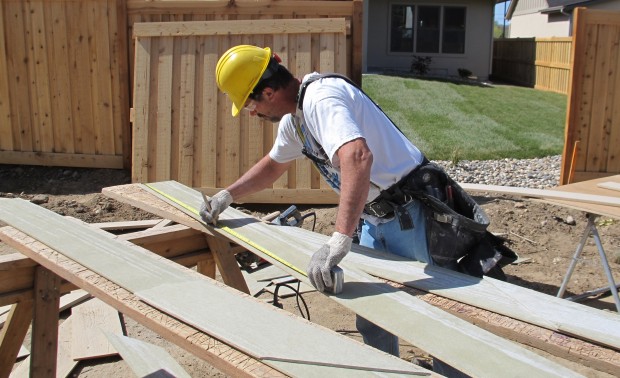Bottom Rung: The Workforce Shift That’s Costing Idaho Good-Paying Jobs

Molly Messick / StateImpact Idaho
A Steelhead Construction worker measures siding for a new home west of Boise.
Not long ago, you could hear the buzz of power saws all over the Treasure Valley. It was punctuated by the steady rhythm of hammers and nail guns. More than 10,000 homes went up in Ada and Canyon counties in the two years before the recession hit. Then, the sound stopped.
“’08 and ’09 were really hard,” says Aaron Wright of Steelhead Construction. He founded the siding and remodeling company as Idaho’s housing boom took hold. At the peak, Wright employed more than 30 people. When the market crashed, he scaled back to three.

Molly Messick / StateImpact Idaho
Aaron Wright, president of Steelhead Construction, employs more than 20 people again, after his staff fell to just three during the recession.
“We’d do a house, maybe two, and then there might be a week and a half gap,” he says. “There was just not a lot of work.”
This week, StateImpact is focusing on low-wage work in Idaho through a series we’re calling “Bottom Rung.” Yesterday’s story offered one explanation for why the state’s low-wage workforce is growing: Retirees are moving in. An aging population demands services, and that means growth in service-sector jobs.
But if service jobs are what Idaho is gaining, what kinds of jobs has Idaho lost?
Construction is an easy culprit, if you’re looking for an industry that has cost Idaho good-paying jobs. On average, construction workers in Idaho made just under $18.50 an hour last year. The industry employs 41 percent fewer people today than it did in 2007.
But retired University of Idaho economist Stephen Cooke says the trouble in Idaho’s workforce runs deeper than the loss of construction jobs.
“That’s a cyclical problem,” Cooke says. “In addition to the cyclical problem, Idaho has a structural problem.”
‘The Economy Is Changing’
Envision the housing boom and bust. In a simple line graph, it’s a steep rise followed by a steep fall — a bell curve. That’s what happened to construction employment, too. The jobs suddenly came, and then they went away.
But that’s not all that has gone on in Idaho’s workforce. Gradually, over the last 15 years, its composition has changed.
“The structural problem is that the nature of the economy is changing,” Cooke explains. “It looked as if Idaho was about to make a very nice transition to a high-skilled manufacturing sector, and then it fell apart.”
Bottom Rung: Living On Low Wages In Idaho
Part 1: Bottom Rung: Two Idaho Workers Talk About Life On Low Wages
Infographic: Bottom Rung: Expenses Are Tough To Pay On Idaho’s $7.25 Minimum Wage
Part 2: Bottom Rung: Why An Influx Of Retirees To Idaho Is Creating More Low-Wage Jobs
Charts: Bottom Rung: Migration By The Numbers
Part 3: Bottom Rung: The Workforce Shift That’s Costing Idaho Good-Paying Jobs
Chart: Bottom Rung: Construction Jobs Gained And Lost, And Their Place In Idaho’s Economy
Bottom Rung: Gov. Otter Touts Idaho’s Low Wages To Attract Gun Companies
Part 4: Bottom Rung: Why Building A Strong Idaho Economy Takes Public Investment
Chart: Bottom Rung: Idaho’s Expanding Call Center Industry
Part 5: Bottom Rung: Why One Idaho Border Business Chose Washington
Bottom Rung: The Politics Of Increasing Idaho’s Minimum Wage
Two-Way: Bottom Rung: Longtime Idaho Economist Stresses Education And Healthcare To Boost Wages
Data: Bottom Rung: Idaho Has More Minimum Wage Workers Than 18 States
Background: Making Money In Idaho, A Guide To Wages
Cooke says this is the important story, and it’s one that has unfolded gradually, obscured by the noise of Idaho’s rapid growth and deep recession. In the 1990s, Idaho looked poised to stake its claim to a sizable number of skilled manufacturing jobs. That stalled. Over 10 years, computer and electronic manufacturing employment in Idaho fell by 40 percent.
Employment in the industry doesn’t follow a bell curve, but a downward slope. Larry Willis knows this firsthand.
“We had five production lines just for the Hewlett-Packard circuit boards we were building,” he says, recalling his years as a production supervisor for electronics manufacturer Jabil Circuit. “I think the total staffing at one point was between 800 and 900?”
Willis moved to Jabil from HP, when HP outsourced its circuit board manufacturing to the company. He was 50 then, and thought he’d be with Jabil until retirement. Instead, the job lasted less than five years.
“It was really a shock,” Willis says of the day he and the rest of the plant’s workers got the news that they were going to lose their jobs. It happened more than a decade ago, but the memory is clear.
“We all had gone to work one day, and all of the sudden we have this announcement to go to the break room,” he remembers. “We were all just sitting in there, not knowing what to expect, and three gentlemen walk in with coats and suits and ties. They walked up to the platform and – just made the announcement that they were going to be shutting the plant down. Nobody had expected that.”
Jabil moved the jobs to plants in Michigan and Florida. In broad terms, it’s a story that has repeated in the Treasure Valley. Boise-based Micron Technology’s largest research and development facility remains in Boise, but it has outsourced at least some of its chip production to Asia.

Molly Messick / StateImpact Idaho
Larry Willis worked for HP and then for electronics manufacturer Jabil Circuit. He lost that job a decade ago, when the company closed its Boise plant.
Falling Behind
Now, Willis works for the state Department of Labor. It’s his job to help other people find jobs. All the time, he’s reminded of how quickly high-paying tech manufacturing work dried up.
“I’m reminded of it by many of the people who come into the Department of Labor who’ve lost jobs, looking for work,” he says. “Many of those people I have worked with in the past, and they may find a job and maybe it lasts for a year, and then they unfortunately are back in here again.”
Today, Aaron Wright, the construction company owner, says business is good. He predicts steady growth, but he also knows the days when construction jobs employed 50,000 Idaho workers are gone. That was a blip.
On the other hand, says economist Steve Cooke, Idaho’s shift away from skilled manufacturing is a long-term trend. It’s one he believes won’t right itself.
“A competitive advantage of America is in our knowledge. Not in our natural resources, so much, or in our low-tech manufacturing,” he explains. “And unless Idaho gets with the program, then it will continually fall behind.”
Skilled workers are a key ingredient of an economy that spirals upward, not down. Cooke argues that this is where Idaho is missing the mark: It’s not investing in its workforce. We’ll pick up with that point tomorrow, when we’ll visit a Boise software company and a call center recruitment fair.

